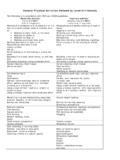Transcription of Designing for Construction Safety: Concepts and Practice
1 Designing for Construction Safety: Concepts and Practice John Gambatese, PhD, PE School of Civil and Construction Engineering Oregon State University 2009 DOE ISM Conference Knoxville, TN August 24-27, 2009 Bio John Gambatese John Gambatese is an Associate Professor in the School of Civil and Construction Engineering at Oregon State University. Dr. Gambatese s educational background includes Bachelor and Master of Science degrees in Civil Engineering from the University of California at Berkeley with emphases in structural engineering, and a in Civil Engineering from the University of Washington in the area of Construction engineering and management.
2 He has worked in industry as a structural engineer, and as a project engineer for a Construction management firm. Dr. Gambatese has taught courses on Construction contracts and specifications, Construction safety and productivity improvement, planning and scheduling, structural analysis and design, temporary Construction structures, and engineering economics. He has performed research and published numerous articles on Construction worker safety, constructability, innovation, Construction contracting, and life cycle properties of civil engineering facilities.
3 He is a member of the American Society of Civil Engineers (ASCE) and American Society of Safety Engineers (ASSE), and actively participates on ASCE s Construction Site Safety Committee, Constructability Committee, and Construction Research Council. He is a licensed Professional Civil Engineer in California. Prevention through Design (PtD) Addressing occupational safety and health needs in the design process to prevent or minimize the work-related hazards and risks associated with the Construction , manufacture, use, maintenance, and disposal of facilities, materials, and equipment.
4 ( ) What is Designing for Construction Safety (DfCS)? Application of Prevention through Design Concepts to Construction worker safety The process of addressing Construction site safety and health in the design of a project Recognizes Construction site safety as a design criterion Safety Constructability Why Design for Construction Safety? 22% of 226 injuries that occurred from 2000-2002 in Oregon, WA, and CA1 42% of 224 fatalities in US between 1990-20031 In Europe, a 1991 study concluded that 60% of fatal accidents resulted in part from decisions made before site work began2 1 Behm, M.
5 , Linking Construction Fatalities to the Design for Construction Safety Concept (2005) 2 European Foundation for the Improvement of Living and Working Conditions Ability to Influence Safety Conceptual Design Detailed Engineering Procurement Construction Start-up High Low Ability to Influence Safety Project Schedule (Source: Szymberski, 1987) the hazard (Design for Safety) the hazard the hazard engineering controls administrative controls personal protective equipment (PPE) Hierarchy of Controls (Sources: Manuele, 1997.)
6 Andres, 2002) Design Examples Example Tools and Processes Begin Concept Design Commence Construction CHAIR-2 CHAIR-3 Project Phase CHAIR-1 Review of Concept Design Review of Detailed Design Construction Hazard Assessment and Implication Review (CHAIR) process Design for Construction Safety ToolBox Example Tools and Processes Design Kickoff Design Internal Review Issue for Construction External Review Trade contractor involvement Establish design for safety expectations Include Construction and operation perspective Identify design for safety process and tools QA/QC Cross-discipline review Focused safety review Owner review (Source: Hecker et al.
7 , 2005) Example Training and Safety Alert System All A/E s attend training courses for: Construction site safety Designing inherently safe buildings Safety Alert System (SAS): Safety reviews during document preparation Safety symbols placed on drawings at locations of potential hazards (Source: The haskell Company, 2004) Integration of Product and Process Design M anufacturingTaxonomy Le v e lsConstructionProjectDivisionActivityBas ic TaskElem ental MotionOrthopedicsCellDesign-Fabrication InterfaceMachineDes ign-Fabrication InterfaceProduct DesignProcess DesignFabricationProduct DesignProcess DesignFabricationTechnology(Source: Everett, and Slocum, , 1994.
8 Automation and Robotics Opportunities: Construction versus Manufacturing. Journal of Construction Engineering and Management, ASCE, Vol. 120, No. 2, pp. 443-452). Benefits of DfCS Safer jobsites Safety hazards eliminated/reduced Fewer injuries and fatalities Reduced workers compensation premiums Increased productivity and quality Fewer delays related to accidents during Construction Allows for continued focus on quality Designer-constructor collaboration Challenges/Barriers to DfCS Change in project team mindset Collaboration Upfront involvement of all stakeholders Contracting.
9 Revised model contracts Alternative contracting methods Availability of visualization and work flow tools Education and training: From separate to integrated DfCS Research Study Response # of Respondents % of Respondents Interested / Willing 7 37% Neutral 9 47% Not interested / Not willing 3 16% Designer willingness to design for safety (Source: Gambatese, Behm, and Hinze, 2005) DfCS Research Study Barrier # of Times Mentioned % of Respondents Interferes with the constructor s means and methods 7 37% Increased liability 5 26% Designers have limited or no Construction experience 4 21% Time constraints.
10 Have enough to deal with 4 21% No control over who gets the bid 4 21% Barriers to Designing for safety (Source: Gambatese, Behm, and Hinze, 2005) DfCS Research Study *QualityFinaloccupantsafetyProject costProjectscheduleAestheticsConstructio nworkersafety*Ranking: 1 = Highest priority 6 = Lowest priority A smaller number represents higher priority. Priority of project criteria (Source: Gambatese, Behm, and Hinze, 2005) Expected Impacts: Trajectories Increased prefabrication Increased use of less hazardous materials and systems Increased Construction engineering Increased spatial investigation Increased collaboration and integration (Source: Toole, and Gambatese, , 2008.)












